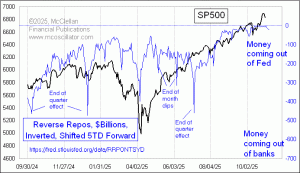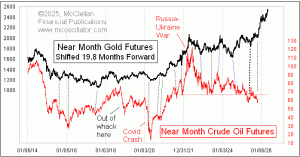Pull the trigger with confidence.We look deeper into market trends. Our analysis puts our readers ahead of price movements... and ahead of the public. For over 40 years, institutional investors and individual traders have relied on our forecasts. Get the edge you've been missing. |

|
Gold’s Stair-Step Pattern

Gold prices are making a repeating stair-step pattern of movements as gold trends higher. Each part of this sequence sees a multi-month up move after breaking out to higher highs, then another multi-month consolidation of those gains. Right now gold is in a consolidation phase.
This week's chart shows our Proportional Price Oscillator, which is a variation on the classic McClellan Price Oscillator. The Price Oscillator which my parents developed back in 1969 is similar to the McClellan... Read More
Decennial Pattern

Years ending in 5 are up years almost without exception through the entire history of the DJIA. The two exceptions were 2005, when the DJIA fell 0.6%, and 2015 with a 2.2% drop. Thus far in 2025, the stock market is back to its normal year 5 behavior, with a 12.5% gain through Dec. 4, 2025. It would have to be a really bad rest of the month to spoil this year 5's record.
This week's chart shows the Decennial Pattern for the DJIA, created by chopping the price history up into 10-year... Read More
Watching for a Zweig Breadth Thrust Signal

Analysts are watching closely to see if we are going to get another Zweig Breadth Thrust Signal within 2025. Created by the late Martin Zweig, the ZBT triggers when a 10-day EMA of Advances divided by Advances plus Declines goes from below 0.40 to above 0.615 within 10 trading days. The numbers of historical instances are pretty low, which is intentional. Zweig wanted to find those rare times when breadth data switched suddenly from bad to really good.
Breadth data had been bad earlier... Read More
VIX Futures Spread Shows Bottoming Condition

The VIX Index was invented in 1989, in a series of papers written by Menachem Brenner and Dan Galai. The CBOE introduced it as an index in 1993, initially using SP100 (OEX) options, but then changing to SP500 options in 2003. See https://cdn.cboe.com/resources/indices/Volatility_Index_Methodology_Cboe_Volatility_Index.pdf for more information on the history of the VIX, and its current formulation.
The CBOE then introduced the first futures contracts based on the VIX in 2004, but those... Read More
Hindenburg Omen Fires 5 Signals

There was some excitement in the world of technical analysis the past two weeks as we saw 5 separate signals fire for something called the Hindenburg Omen. This is a warning signal of trouble, but trouble does not always come. What is fair to say is that Hindenburg Omen signals have appeared at every major stock market top going back several decades. But they have also appeared at other times.
The creator of this signal was the late James Miekka, who died tragically in 2014. Miekka was... Read More
Looming Slowdown Is The Fed’s Fault

The Challenger, Gray, & Christmas report on corporate layoffs just posted at 153,000, the worst October since 2003. Economists are floating numerous explanations for this, including the government shutdown, tariffs, and other "usual suspects". But I am going to put the blame right at the feet of the Federal Reserve, for having kept interest rates too high since 2023.
My definition for "too high" is the 2-year T-Note yield, shown in this week's chart. I first wrote about that here in... Read More
Reverse Repos: A Dead Issue (Or Are They?)

I wrote here back in September 2025 about how the total amount of Reverse Repurchase (RRP) agreements at the Federal Reserve was bottoming out, and how they were thus ceasing to be an issue for the stock market. That thesis needs a review, given the past few days' data.
To review, a regular Overnight Repurchase Agreement (or Overnight Repo for short) is a transaction between the Fed and a member bank in which the Fed effectively lends money to a bank. The process involves the sale of... Read More
Inflection Point for Crude Oil

Crude oil futures prices in the US have dipped to below $60/barrel, in spite of sanctions on Russian oil and other stresses in the energy markets. Proponents of "Drill, Baby, Drill" are celebrating this price drop, as are motorists enjoying low average gasoline prices.
But the party is about over, according to the leading indication given by gold prices. This week's chart is one I have shown here before, and it involves shifting forward the plot of gold prices by 19.8 months to reveal how... Read More
Download Latest Reports
(Subscription Required)
The McClellan Oscillator
 Created 1969, the McClellan Oscillator is recognized by technical analysts as the essential tool for measuring acceleration in the stock market. Using advance-decline statistics, it gives overbought and oversold indications, divergences, and measurements of the power of a move.
Created 1969, the McClellan Oscillator is recognized by technical analysts as the essential tool for measuring acceleration in the stock market. Using advance-decline statistics, it gives overbought and oversold indications, divergences, and measurements of the power of a move.Free Chart In Focus Email
Our Work in the News
- Foundation for the Study of Cycles - Technical Analysis Masterclass with Sherman McClellan | Cycles TV March 15, 2025
- Market Misbehavior - The Origin Story of the McClellan Oscillator
- CNBC - Here’s Why Gold is a Leading Indicator for Oil
- Wealthion - Adam Taggart Interviews Tom - Part 2
- Wealthion - Adam Taggart Interview’s Tom - Part 1
Latest Articles
 The McClellan Oscillator & Summation Index
The McClellan Oscillator & Summation Index Useful Analysis Links
Useful Analysis Links- The Origin Story of the McClellan Oscillator
- The Intersection of Stock Market & Political Races
- Fox Business Appearance
- Tom on CNBC
- 20 Years Publishing This Newsletter
- Tom on Apple’s Massive Market Cap
- Hindenburg Omen Chart for Dec. 4 CNBC Interview
- Could market see September selloff?
